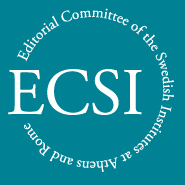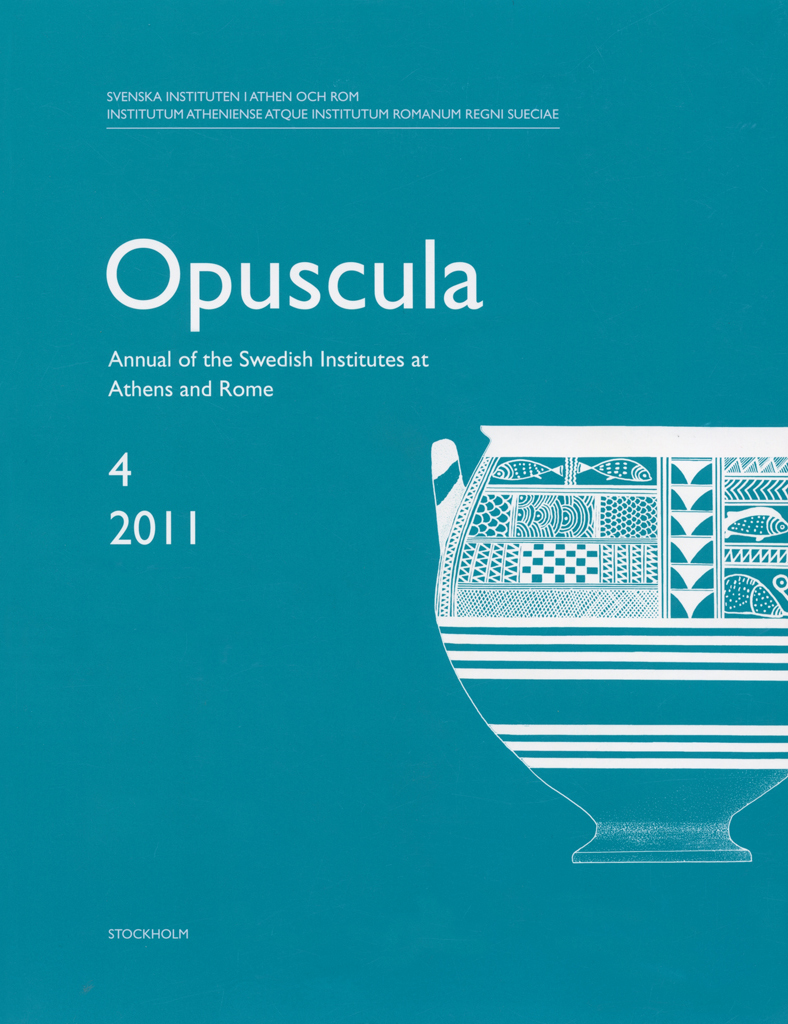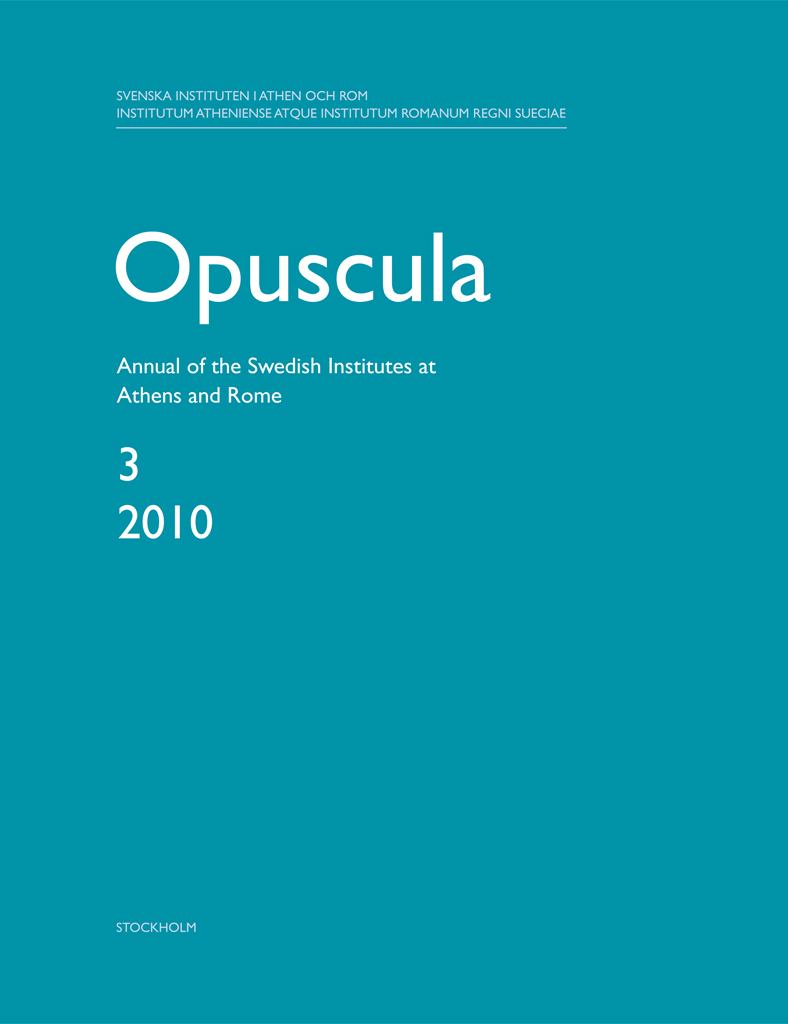Opuscula is published by the Swedish Institutes at Athens and Rome, with the aid of a grant from the Swedish Research Council. Distributed by Eddy.se AB. View journal at ERIH PLUS. All content available with open access. Representing consulship. On the concept and meanings of the consular diptychs By Cecilia Olovsdotter Abstract Although the consular diptych does not appear as a distinct category of art until the end of the Roman consulate’s thousand-year history (c. 400–541), it constitutes a primary example of the continuance of Roman honorific tradition, developing concurrently with the division and transformation of the Roman empire and the resurgence of the consulate as the most prestigious office on the cursus honorum. By analysing and interpreting the patterns of motif selection, compositional structure and representational mode in the consular diptychs, it is possible to trace the various contextual factors, cultural and historical, that contributed towards their conception, and to gain valuable insights into the precepts of the late antique ‘ideology of consulship’ that was transmitted through this new visual medium. The present article discusses the different layers of meaning within the consular imagery, conveyed through an increasing elaboration and regularization of form and content, from the basic theme…
Opuscula is published by the Swedish Institutes at Athens and Rome, with the aid of a grant from the Swedish Research Council. Distributed by Eddy.se AB. View journal at ERIH PLUS. All content available with open access. The New Swedish Cyprus Expedition 2010. Excavations at Dromolaxia Vizatzia/Hala Sultan Tekke. Preliminary results. With appendices by P. Klingborg, F. and F. Kärfve, C. Hagberg, O. Svensson, S. Macheridis and L. Franz By Peter M. Fischer, with appendices by P. Klingborg, F. Kärfve, F. Kärfve, C. Hagberg, O. Svensson, S. Macheridis, L. Franz Abstract Determination of the complete occupational sequence of the site, including investigation of pre-12th century levels which were thoroughly studied by P. Åström since the 1970s, is the main task of the planned project. During the course of the expedition (NSCE11) in spring 2010 a ground-penetrating radar survey (GPR) was carried out at Dromolaxia Vizatzia/Hala Sultan Tekke in Area 6, leading to the discovery of a large Late Cypriote complex. The compound is bordered to the north by a substantial wall, against which nine rooms (so far) could be exposed. Two occupational phases have been verified but there are indications of a third. The suggested functions of the various structures…
Opuscula is published by the Swedish Institutes at Athens and Rome, with the aid of a grant from the Swedish Research Council. Distributed by Eddy.se AB. View journal at ERIH PLUS. All content available with open access. Labraunda 2010. A preliminary report on the Swedish excavations By Lars Karlsson, Jesper Blid & Olivier Henry Abstract The campaign of 2010 continued the work which was initiated last year. The excavations in the fortress on the Tepesar Hill were completed. The fortress consists of a large, early Hekatomnid tower where two black-gloss vessels indicated a dating of the tower to about 380–350 BC. In the two additions to the tower, several wellpreserved vessels dating from the 3rd century BC were uncovered. The latest fragment was a painted piece from a lagynos from around 200 BC, but there were no fragments of Megarian bowls. The test probe of last year in the West Church Complex was extended to a larger trench measuring c. 9 × 12 m. Evidence for three major phases could be established by J. Blid: (1) a Late Classical stoa; (2) the stoa colonnade is rebuilt into a Christian basilica of the 5th century AD; (3) a Middle Byzantine building…
Opuscula is published by the Swedish Institutes at Athens and Rome, with the aid of a grant from the Swedish Research Council. Distributed by Eddy.se AB. View journal at ERIH PLUS. All content available with open access. A courtyard gate at Thourioi By Henrik Gerding Abstract In the early seventies Paola Zancani Montuoro suggested that a large paved structure, which had recently been uncovered at the site of Sybaris/Thourioi in southern Italy, was the remains of an ancient neosoikos, or shipshed. This idea quickly gained widespread acceptance and is still often repeated, despite some objections having been raised. In this paper it is argued that the structure, which cannot have been a shipshed, was actually a courtyard gate belonging to the Late Classical or Early Hellenistic city wall of Thourioi. Bibliographical information Henrik Gerding, ‘A courtyard gate at Thourioi’, Opuscula. Annual of the Swedish Institutes at Athens and Rome (OpAthRom) 4, 7–18. Stockholm 2011. ISSN: 2000-0898 ISBN: 978-91-977798-3-8. Softcover, 168 pages. https://doi.org/10.30549/opathrom-04-02
Opuscula is published by the Swedish Institutes at Athens and Rome, with the aid of a grant from the Swedish Research Council. Distributed by Eddy.se AB. View journal at ERIH PLUS. Content available with open access. Pictures and people. Seals, figurines and Peloponnesian imagery By Erika Weiberg Abstract The point of departure for this paper is the publication of two Early Helladic sealing fragments from the coastal settlement of Asine on the north-east Peloponnese in Greece. After an initial description and discussion they are set in the context of sealing custom established on the Greek mainland around 2500 BCE. In the first part of the paper focus is on the apparent qualitative differences between the available seals and the contemporary seal impressions, as well as between different sealing assemblages on northeastern Peloponnese. This geographical emphasis is carried into the second part of the paper which is a review and contextualisation of the representational art of the Aegean Early Bronze Age in general, and northeastern Peloponnese in particular. Seal motifs and figurines are the main media for Early Helladic representational art preserved until today, yet in many ways very dissimilar. These opposites are explored in order to begin to build a…
Opuscula is published by the Swedish Institutes at Athens and Rome, with the aid of a grant from the Swedish Research Council. Distributed by Eddy.se AB. View journal at ERIH PLUS. Content available with open access. Chiusi e il Clusium Group. Un nuovo documento dagli scavi di Orvieto By Fernando Gilotta Abstract This note deals with sherds of a very important “new” Etruscan red-figure cup from Orvieto (Excavations Campo della Fiera, 2006), showing a fragmentary group of Fufluns/Satyr and a winged female goddess. The poorly preserved paintings, close to the “Clusium Group” as far as the central medaillon is concerned, are reminiscent of older “tiberine” vases, such as the Casuccini stamnos and related pottery, and at the same time show intriguing links with later Faliscan and Campanizing red-figure. This combination of stylistic and workshop relationships sheds light on the milieu from which the Clusium Group (possibly) emerged around the middle of the fourth century BC. As for the kylix, a date toward the third quarter of the fourth century BC is suggested. Bibliographical information Fernando Gilotta, ‘Chiusi e il Clusium Group. Un nuovo documento dagli scavi di Orvieto’, Opuscula. Annual of the Swedish Institutes at Athens and Rome (OpAthRom) 3,…
Opuscula is published by the Swedish Institutes at Athens and Rome, with the aid of a grant from the Swedish Research Council. Distributed by Eddy.se AB. View journal at ERIH PLUS. Content available with open access. Marsyas in the garden? Small-scale sculptures referring to Marsyas in the forum By Julia Habetzeder Abstract While studying a small-scale sculpture in the collections of the Nationalmuseum in Stockholm, I noticed that it belongs to a previously unrecognized sculpture type. The type depicts a paunchy, bearded satyr who stands with one arm raised. To my knowledge, four replicas exist. By means of stylistic comparison, they can be dated to the late second to early third centuries AD. Due to their scale and rendering they are likely to have been freestanding decorative elements in Roman villas or gardens. The iconography of the satyrs of the type discussed is closely related to that of a group of fountain figures. These fountain figures are believed to refer to a motif well known in Roman times: the Marsyas in the forum. In this article I argue that the satyrs of the type discussed refer as well to this once famous depiction of Marsyas. Bibliographical information Julia Habetzeder, ‘Marsyas…
Opuscula is published by the Swedish Institutes at Athens and Rome, with the aid of a grant from the Swedish Research Council. Distributed by Eddy.se AB. View journal at ERIH PLUS. Content available with open access. Water, well-being and social complexity in Insula V 1. A Pompeian city block revisited By Anne-Marie Leander Touati Abstract Swedish archaeologists have been working in Pompeii since 2000. Our fieldwork has consisted mainly of the study of standing walls and cleared floor levels in a city block unearthed in the 19th century and of the production of a comprehensive documentation, presented in an open access publication: www.pompejiprojektet.se/insula.php. The perspective of the present paper is the insula as a whole. Its main study objects are features of recurrent nature that in varying form and frequency are found in many of the separate houses and other units that constitute this insula: for example, the divergent materials used for the rubble masonry in the first phase of urbanisation, structures used for water management such as water supply and drains, possible earthquake damage and resulting repairs, preferences for where kitchens and sanitary installations are placed, markers indicating property borders and dependencies such as pavement curbing, courses of water…
Opuscula is published by the Swedish Institutes at Athens and Rome, with the aid of a grant from the Swedish Research Council. Distributed by Eddy.se AB. View journal at ERIH PLUS. Content available with open access. Labraunda 2009. A preliminary report on the Swedish excavations with contributions by Jesper Blid and Olivier Henry By Lars Karlsson Abstract The 2009 campaign in Labraunda accomplished three goals: the termination of the excavations in the Byzantine fort on the Acropolis and in the Late Roman Tetraconch and the complete excavation of the impressive marble chamber tomb along the Sacred Way. In the Acropolis Fortress, evidence was found to support the military character of the Byzantine establishment: the rooms along the fortification wall were paved and had a rectangular shape, suggesting defensive rooms. In these rooms sling stones were found. Structures dating from the Hekatomnid period were further investigated this year, and a well cut into the gneiss bedrock was excavated. In the Tetraconch, the north apse was excavated down to bedrock and a coin from Constantius II (348–357/8) suggests an ante quem dating for this unique and sophisticated structure. The geophysical investigations indicated that a church is located on the terrace below the…
Opuscula is published by the Swedish Institutes at Athens and Rome, with the aid of a grant from the Swedish Research Council. Distributed by Eddy.se AB. View journal at ERIH PLUS. Content available with open access. Un inedito lastrone a scala da Tarquinia presso l’Antiquiarum di Monte Romano By Maria Gabriella Scapaticci Abstract This is the publication of an as yet unpublished recently acquired large stepped slab dating from the orientalising period. It was delivered to the Antiquarium of Monte Romano (Vt) by the local resident who found it. The find comes from the “Ancarano” area of Tarquinia which is near the border of the Monte Romano district. The piece is of the stepped slab class, typical of seventh century BC production from Tarquinia. The slab completes a similar one which was also from Tarquinia but is conserved in the Archaeological Museum of Florence and was purchased from Mr Milani in Tarquinia at the end of the nineteenth century. Through photocomposition and integrated graphic restoration we propose a reading which links the two finds. Hence the decoration of an important funerary monument has emerged, most likely belonging to an Etruscan prince who recounts his hunting exploits, which are symbolic of…


